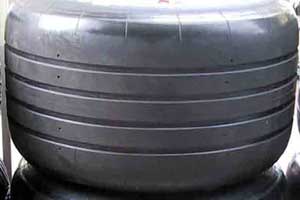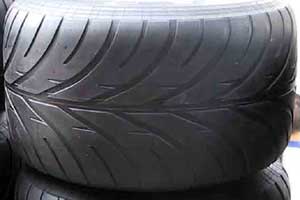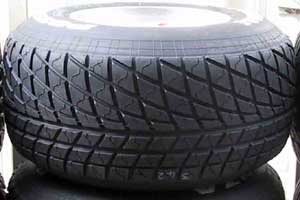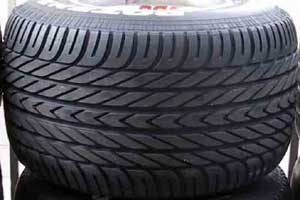Features - News Feature
JUNE 26, 2002
The opposing forces in the tire war
BY JOE SAWARD

One of the most important elements in Formula 1 in recent years has been the performance of the tires and for the last 18 months there has been a gradually escalating battle for supremacy between Bridgestone and Michelin. The aim of both companies is to sell more tires around the world and with market research suggesting that 35% of customers are influenced by success in Grand Prix racing, the battle is on.
Bridgestone took the plunge in 1997 and took on Goodyear with a string of small teams. Damon Hill, driving for Arrows, nearly won the Hungarian Grand Prix - and the bigger F1 teams began to sit up and take notice. In November that year Goodyear announced that it was planning to withdraw from F1 at the end of 1998 because it did not want to get involved in an auction to win over the top teams.
"If you ring up Ferrari and offer them your tires," one tire man reported, "they will say "Fine. It will cost you X million dollars."
Soon after the announcement McLaren and Benetton both jumped to Bridgestone and in the summer of 1998 McLaren dominated.
Bridgestone won its first world title in only its second year.
The lobbying for Goodyear remained intense and in April 1998 even Bridgestone became involved.
"We are disappointed that Goodyear has announced plans to withdrew," said Bridgestone's F1 boss Hiroshi Yasukawa "We hope Goodyear will change its mind and remain in F1."
|
|||
|
|||
|
|||
|
Bridgestone had been delighted by the early results of the F1 program
"In order to measure the impact of F1," says Bridgestone's marketeer Bruno Frachon. "We carried out a market research survey between April and June 1998 in five major European markets. We then compared this to figures from 1996. We discovered that on average the spontaneous brand awareness had more than doubled with an average increase of 123%. That is an exceptionally good result and in some countries - France and Spain for example - the figure had almost tripled."
While Bridgestone and Goodyear tussled in F1, Michelin watched the action. As early as 1995 the French company had a secret research group in Clermont-Ferrand working on F1 tire development but the company stayed out of F1. But on December 16 1999 the company announced that it would be entering F1 in 2001 with BMW Williams and Toyota.
"This decision is part of our worldwide strategy " Edouard Michelin the Chief Executive of the Michelin Group reported." Racing and F1 in particular present a very strong potential in terms of communicating our technological leadership. Our entry in F1 will help us reinforce our position in Europe and gain recognition and improve our presence in Asia and South America. It will also increase our racing presence in North America. We are convinced that this is a good investment ".
By the start of 2001 Michelin had done deals with Jaguar, Prost, Benetton and Minardi as well and the first Michelin win came in the fourth race with Ralf Schumacher at Imola. Ralf won again in Canada and Germany and Juan Pablo Montoya added a fourth victory in Italy. Michelin had done well. Over the winter Prost disappeared but Michelin took on McLaren and Toyota and so entered this year with six teams to Bridgestone's five.
When you analyze the Bridgestone and Michelin operations it is amazing how similar they are in terms of size and procedures. Bridgestone says that it has 100 people working on the program in Japan and a smaller group in Europe. There are around 15 engineers at each race and about half of them are European, rather than Japanese. The team sends four trucks of tires (around 1600) and a motorhome to each race. There are separate testing organizations although the engineers tend to go to races and tests, although they are rotated so they get some rest.
The Bridgestone F1 technical team comes under the control of the Motor Sport Tire Development Department at Kodaira in Tokyo which is headed by Hirohide Hamashima. He oversees the compound development and tire design teams in Japan and the British operation, which is under the technical control of Hisao Suganuma, and is based in Langley in England. This satellite operation runs European operations but the tires are all handmade at Kodaira in Japan. The Langley operation is managed by Naotaka Horio, with logistics being overseen by Peter Grzelinski, a Briton with Polish ancestry, who has been working in the racing tire industry for 30 years. The tire fitters are British.
The design of the tires changes from race to race and the team is very guarded about how long it takes to make a batch of new tires but recent events have suggested that it can be done in the space of three or four days. The pace of development is impressive and so too is the company's ability to use up money. Bridgestone says that it spends around $150m a year in F1, although the figure includes all trackside signage as well as the technical operation. The whole program comes under the control of the company's Director of Motorsport Hiroshi Yasukawa.
The 51-year-old has been with Bridgestone for his entire working career and is largely responsible for the company's successes in the sport for the last 20 years having taken over as head of motorsport in 1981.
Yasukawa's counterpart at Michelin is 64-year-old Frenchman Pierre Dupasquier, a former French Air Force pilot who has worked in Michelin's research and development departments since 1962 and has been head of competition since 1973 (although he had a spell in product engineering in the United States in the late 1980s.
Dupasquier's Entite Tactique Competition has a series of different departments under his control each headed by a different engineer, These look after the different Michelin sporting involvements in motorbikes, rallying, sports cars and so on. The Formula 1 division is headed by Pascal Vasselon (who came to F1 from GT racing) and is based at Cataroux, one of the Michelin factories in and around Clermont Ferrand in central France.
Vasselon runs an organization which has three engineers per team (giving the company a total of 19 engineers at each race). They are 60% French but include a variety of other nationalities. The company has 120 people working on the F1 project and sends six trucks (carrying 2000 tires) and a hospitality unit to each race. The engineers go to races and tests but like the Bridgestone men are rotated so that they get some rest. The company can produce completely new tires between races and the tires are almost all now designed for the particular race in question. The organization is overseen by Henny de Zeeuw, a Dutchman, who works with two coordinators bother career Michelin men from Clermont-Ferrand, Jean-Francois Collange and Jose Nunez.
This year the score is five-one to Bridgestone but as tires are being changed at every event, that situation could change quickly.
Nothing stands still in the tire war...



